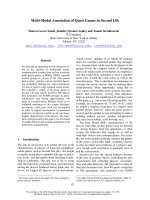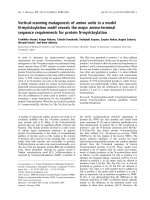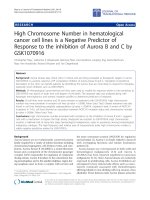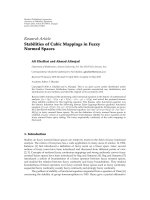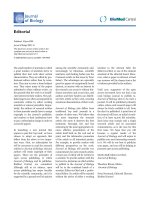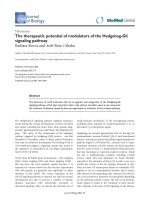Báo cáo sinh học: "Second chromosome polymorphism of Drosophila buzzatii in a natural population is not associated with gametic selection and does not affect mating pattern" potx
Bạn đang xem bản rút gọn của tài liệu. Xem và tải ngay bản đầy đủ của tài liệu tại đây (910.34 KB, 16 trang )
Note
Second
chromosome
polymorphism
of
Drosophila
buzzatii
in
a
natural
population
is
not
associated
with
gametic
selection
and
does
not
affect
mating
pattern
C
Rodriguez
1
E
Hasson
JJ
Fanara
JC
Vilardi
2
!
GIBE,
Universidad
de
Buenos
Aires,
Facultad
de
Ciencias
Exactas
y
Naturales,
Depto
Cs
Biológicas,
Ciudad
Universitaria
Pab
11,
1428
Buenos
Aires;
2 Universidad
de
Buenos
Aires,
Facultad
de
Cí
encias
Exactas
y
Naturales,
Depto
Cs
Biológicas,
Laboratorio
de
Genetica,
Ciudad
Universitaria
Pa6
11,
1428
Buenos
A
ires,
!4n/en<!na
(Received
31
January
1991;
accepted
13
January
1992)
Summary -
In
previous
work
we
have
demonstrated
the
adaptive
significance
of
the
chromosomal
polymorphism
of
D
buzzatii
in
a
natural
population
from
Argentina
by
means
of
selection
components
analysis.
The
experimental
design
employed
for
this
purpose
was
based
on
4
general
assumptions.
The
results
reported
in
the
present
study
allow
us
to
verify
3
of
these
assumptions:
i)
mating
is
at
random,
irrespective
of
the
flies
karyotype;
ii)
gametic
selection
may
be
considered
absent;
and
iii)
there
is
no
differential
attraction
of
flies
to
the
collecting
baits.
The
validity
of
these
assumptions
gives
strong
support
to
the
conclusions
reached
in
our
previous
selection
components
analysis.
mating
pattern
/
gametic
selection
/
chromosomal
polymorphism
Résumé -
Le
polymorphisme
du
deuxième
chromosome
de
Drosophila
buzzatü
dans
une
population
naturelle
n’est
pas
associé
à
une
sélection
gamétique
et
n’affecte
pas
le
mode
d’accouplement.
Dans
un
travail
précédent,
nous
avons
démontré
la
signification
adaptative
du
polymorphisme
chromosomique
de
D
buzzatii
dans
une
population
naturelle
d’Argentine,
à
l’aide
d’une
analyse
de
la
sélection
en
ses
composantes.
Le
plan
d’expérience
utilisé
dans
ce
but
était
basé
sur
quatre
hypothèses.
Les
résultats
présentés
dans
le
présent
travail
permettent
la
vérification
de
trois
d’entre
elles:
i)
l’accouplement
se
produit
au
hasard,
indépendamment
du
karyotype
des
mouches;
ii)
la
sélection
gamétique
est
absente;
iii)
il
n’y
a
pas
d’attraction
différentielle
des
mouches
vers
les
pièges
de
récolte.
La
*
Correspondence
and
reprints
vérification
de
ces
hypothèses
confirme
les
conclusions
établies
dans
notre
précédente
analyse
des
composantes
de
la
sélection.
mode
d’accouplement
/
sélection
gamétique
/
polymorphisme
chromosomique
/
drosophile
INTRODUCTION
Several
methodological
approaches
have
been
applied
to
the
study
of
natural
selection
in
nature
(see
Endler,
1986
for
a
review).
One
of
them
consists
of
dividing
total
selection
into
partial
components
throughout
the
life-cycle
(selection
components
analysis)
(Hedrick
and
Murray,
1983).
This
approach
was
employed
to
investigate
the
adaptive
significance
of
chromosomal
polymorphisms
in
wild
populations
of
the
cactophilic
fly
Drosophila
buzzatii
(Ruiz
et
al,
1986;
Hasson
et
al,
1991).
These
authors
demonstrated
not
only
the
adaptive
significance
of
the
second
chromosomal
polymorphisms,
but
also
that
certain
chromosomal
arrangements
are
favoured
during
one
selective
episode
and
selected
against
in
another,
a
pattern
called
endocyclic
selection.
Moreover,
they
suggested
that
this
pattern
might
be
involved
in
the
maintenance
of
polymorphisms.
However,
their
conclusions
are
based
on
the
validity
of
4
assumptions;
i),
random
mating;
ii),
absence
of
gametic
selection;
iii),
lack
of
differential
attraction
of
flies
to
the
collecting
baits;
and
iv),
lack
of
selection
in
the
laboratory
(see
Ruiz
et
al,
1986).
In
the
present
work
we
report
the
results
of the
analysis
of
the
first
3
assumptions,
with
the
aim
of
providing
experimental
support
for
our
previous
results.
MATERIAL
AND
METHODS
D
buxzatii
is
a
cactophilic
species
that
breeds
and
feeds
on
the
decaying
cladodes
of
several
Opuntia
species.
The
present
work
was
performed
in
the
natural
population
of
Arroyo
Escobar,
where
D
buzxatii
breeds
on
the
rotting
cladodes
of
Opuntia
vulgaris
(for
a
description
of
this
locality,
see
Hasson
et
al,
1991).
Wild
flies
were
caught
in
May
1987
by
net
sweeping
on
fermented
banana
baits.
Flies
were
immediately
sexed
and
females
were
maintained
in
individual
vials
with
David’s
(1962)
killed
yeast
culture
medium
at
25°C.
The
analyses
of
8
larvae
from
the
progeny
of
each
wild
inseminated
female
allowed
us
to
assess
the
karyotype
for
the
second
chromosome
of
both
parents
assuming
that
the
progeny
of
each
female
was
fathered
by
a
single
male.
Three
chromosome
arrangements
were
identified:
st
(standard),
2j
and
2jz
3.
Observed
mating
frequencies
were
compared
with
those
expected
by
random
mating
by
means
of
x2
tests.
Goodness
of
fit
to
Mendelian
proportions
was
studied
by
means
of
X2
tests
for
each
mating
class.
Since
the
observed
karyotypic
proportions
in
some
mating
classes
departed
from
the
expected
(see
below),
the
segregation
of
2j/st
and
2j Z3 / st
heterokaryotypes
was
studied
in
more
detail.
This
analysis
was
performed
with
heterozygous
individuals
obtained
by
crossing
flies
from
homozygous
stocks.
These
stocks
were
obtained
through
consanguineous
crosses
among
the
progeny
of
several
wild
females.
Seventeen
lines
homozygous
for
2j,
14
for
2jz
3
and
4
for
2st
were
isolated,
and
individually
maintained
until
employed
in
further
experiments.
Heterokaxyotypes
were
produced
through
both
reciprocal
crosses
by
setting
together
100
mature
virgin
females
and
100
mature
males
of
the
corresponding
homozygous
stocks
in
an
egg
collecting
chamber.
Heterozygous
eggs
were
seeded
in
culture
bottles
in
uncrowded
conditions
(6-8
eggs
per
ml
of
culture
medium).
One
hundred
heterokaryotypic
5-day-old
flies
were
crossed
with
100
flies
of
each
of
the
3
homokaryotypic
stocks.
Flies
were
introduced
into
an
egg
collecting
chamber
for
a
48
h
period.
The
collecting
medium
was
changed
every
24
h.
In
all
cases,
both
reciprocal
crosses
were
made.
Eggs
were
allowed
to
hatch
and
500
first
instar
larvae
were
seeded
in
5
culture
bottles
(100
larvae
each)
containing
40
cc
of
culture
medium
for
each
cross,
in
low
density
conditions
and
maintained
at
25°C.
Thirty-two
third
instar
larvae
from
each
bottle
were
sampled
and
their
salivary
gland
chromosomes
analyzed,
according
to
Fontdevila
et
al
(1981).
Observed
karyotypic
proportions
in
the
offspring
of
each
cross
were
compared
to
those
expected
by
means
of
goodness
of
fit
X2
tests.
The
remaining
individuals
in
the
bottles
were
maintained
until
pupation
in
order
to
estimate
larval
viability
by
counting
all
pupae.
Further
collections
were
performed
in
A
Escobar
in
March
1989
by
means
of
banana
baits
and
with
Opuntia
vulgaris
rotting
cladodes,
in
order
to
test
the
assumption
that
flies
were
not
differentially
attracted
to
the
collecting
baits.
RESULTS
The
frequencies
estimated
for
second
chromosome
arrangements
were:
standard
(st)
= 0.110; j
= 0.575
and jz
3
= 0.315.
The
observed
and
random
mating
expected
numbers
of
each
mating
class
are
shown
in
table
I.
Since
the
frequencies
of
certain
mating
classes
were
extremely
low,
goodness
of
fit
tests
were
performed
for
each
chromosomal
arrangement.
None
of
the
X2
values
was
significant
(table
II).
Additionally,
Mendelian
segregation
was
tested
for
the
most
common
mating
classes.
The
results
shown
in
table
III
revealed
significant
departures
in
crosses
j/st
x
j/j;
il
st
x
j/jz
3
and
jz
3
/st
x
j/j.
From
this
analysis
it
may
be
concluded
that
a
deficiency
of
2st
bearing
individuals
occurred
in
all
cases.
These
results
could
suggest
gametic
selection
against
2st.
To
test
this
hypothesis,
flies
heterozygous
for
2st
were
backcrossed
with
individuals
from
the
3
homokaryotypic
stocks.
Significant
departures
from
expected
values
were
detected
only
in
2
independent
crosses
of
2j/st
males
with
2st/st
females
(table
IV,
fourth
row)
with
homogeneous
results
(x
2
=
0.09,
df
=
1P
>
0.75).
This
bias
cannot be
attributed
to
selection
in
the
laboratory
because
there
was
no
relationship
between
viability
(table
IV,
fifth
column)
and
segregation
distortion
for
each
cross.
The
results
of
the
reciprocal
cross
did
not
depart
from
the
expected
values
and
when
pooling
the
progeny
that
received
2st
versus
2j
in
all
crosses
involving
the
2st/j
heterokaryotype
(from
table
IV),
the
x2
value
was
not
significant
(x2
=
3.13,
df
=
1,
P
>
0.05).
Likewise,
none
of
the
crosses
involving
the
2st fj z
3
parents
showed
a
significant
distortion
in
the
segregation
pattern.
However,
all
crosses
involving
heterozygous
2st/*
parental
males
showed
a
homogeneous
trend
(X2
=
5.03,
df
=
5,
P
>
0.25)
of
2st
deficiency,
and
when
the
progeny
of
these
crosses
was
pooled
according
to
the
arrangement
received
from
their
parental
males:
st(N
=
413)
and
non
st
(N
=
488)
a
significant
distortion
from
1:1
was
observed
(X2
=
6.24,
df
=
1,
P
<
0.025).
This
effect
was
absent
in
the
reciprocal
crosses
(st/*
parental
females)
(419:419)
(table
IV).
The
validity
of
the
assumption
that
flies
were
not
differentially
attracted
to
the
collecting
baits
was
tested
in
March
1989.
Chromosomal
frequencies
estimated
in
samples
of
adult
flies
collected
by
means
of
banana
baits
and
with
rotting
cladodes
were
not
significantly
different
(X2
=
5.57,
df
=
2, P
>
0.05,
N
=
189),
pointing
to
the
fact
that
flies
were
attracted
to
the
baits
irrespective
of
their
karyotype.
DISCUSSION
Random
mating
is
a
general
assumption
in
almost
all
models
devised
for
population
genetics
purposes.
In
the
D
buzzatii
natural
population
of
Arroyo
Escobar,
observed
mating
frequencies
of
second
chromosome
karyotypes
did
not
depart
significantly
from
those
expected,
giving
support
to
the
assumption
of
random
mating.
This
result
is
in
agreement
with
those
obtained
by
Ruiz
et
al
(1991)
in
a
Spanish
natural
population
of
D
buzzatii.
However,
our
analysis
is
based
on
the
assumption
that
the
offspring
of
each
wild
inseminated
female
was
fathered
by
a
single
male.
Concerning
this,
female
remat-
ing
has
often
been
observed
in
several
species
of
Drosophila
(Loukas
et
al,
1981;
Markow,
1982).
The
frequency
of
multiple
inseminations
is
dependent
on
environ-
mental
conditions
such
as
population
density
(Turner
and
Anderson,
1983)
and
on
the
species
considered
(Markov,
1982).
In
the
present
work,
flies
were
collected
in
mid-autumn,
when
their
density
and
activity
were
low.
Multiple
insemination
events
in
the
present
work
were
detected
only
in
a
few
cases
(less
than
1% ),
which
were
not
considered
in
the
analysis,
because
it
was
not
possible
to
ascertain
their
parental
karyotypes.
Multiple
insemination
frequency
was
underestimated
because
some
events
might
have
been
undetected;
however,
the
close
fitting
of
parental
kary-
otype
frequencies
to
Hardy-Weinberg
expectations
(x2
=
4.38,
df
=
2,
P
>
0.05)
gave
support
to
the
assumption
that
female
remating
should
not
contribute
to
bias
our
results.
In
the
segregation
analysis,
it
should
be
noted
that
the
departure
from
Mendelian
segregation
shown
in
table
III
was
observed
in
culture
vials
in
which
the
larval
density
was
not
under
experimental
control;
thus,
larval
selection
favoring
2j
or
2jz
3
cannot
be
ruled
out.
Crosses
involving
heterokaryotypes
2 j/st
and
2st/jz
3
performed
under
controlled
laboratory
conditions
yielded,
in
general,
segregation
patterns
that
did
not
depart
from
those
expected,
though
a
trend
towards
a
deficiency
of
2st
in
the
progenies
of
males
heterozygous
for
2st
was
observed.
This
suggests
the
occurrence
of
gametic
selection
against
2st.
Yet
it
should
be
noted
that
the
stlst
homokaryotypic
stock
was
obtained
from
only
4
independent
chromosomes;
thus
the
distortion
observed
might
be
the
consequence
of
a
homozygous
residual
genotype.
Therefore,
new
experiments
with
2st
strains
derived
from
more
independent
chromosomes
are
necessary
to
test
the
significance
of
this
observation.
Nonetheless,
the
frequency
of
2st
in
Arroyo
Escobar
is
relatively
low,
the
expected
frequency
of
the
cross
2j/st
males
x2st/st
females
would
be
less
than
5.6
10-
4,
and,
taking
into
account
that
the
observed
segregation
distortion
was
nearly
60:40,
it
can
be
concluded
that
the
present
results
do
not
necessarily
invalidate
the
conclusions
of
our
selection
components
analysis
(Hasson
et
al,
1991).
Furthermore,
even
though
the
expected
frequency
of
crosses
involving
2st
heterozygous
males
in
the
population
of
Arroyo
Escobar
would
be
about
0.05,
the
observed
segregation
distortion
was
just
4%
(46:54).
Therefore
the
deficiency
of
2st
progeny
should
be
nearly
0.2%.
Once
again,
the
assumption
of
absence
of
gametic
selection
seems
to
be
acceptable.
Thus,
the
results
reported
herein
give
support
to
the
conclusions
reached
in
our
previous
paper.
They
demonstrate
that
the
assumptions
of
lack
of
differential
attraction
of
flies
to
the
collecting
baits
and
random
mating
can
be
accepted,
and
even
the
apparent
weak
gametic
selection
against
2st
would
not
affect
our
previous
results.
ACKNOWLEDGMENTS
The
authors
wish
to
thank
to
Dr
OA
Reig
for
helpful
discussions
and
constructive
criticisms
of
the
manuscript.
Dr
A
Fondevila
suggested
the
importance
of
undertaking
these
studies.
We
are
indebted
to
Dr
G
Tell
and
L
M
Giurfa
for
the
French
translation
of
the
title
and
summary.
The
English
language
of
this
paper
was
improved
by
the
revision
of
Mr
FJ
Dyzenchauz.
The
critical
comments
of
two
anonymous
reviewers
are
also
gratefully
acknowledged.
This
work
was
supported
by
CONICET
grant
PIA
004-422/87
and
by
Universidad
de
Buenos
Aires
grant
EX
030/87
awarded
to
OA
Reig.
EH
is
fellow
of
CONICET-Argentina,
JJF
is
a
fellow
of
the
Universidad
de
Buenos
Aires
and
JCV
is
a
member
of
the
Carrera
del
Investigador
Ceintffico
of
CONICET.
REFERENCES
David
J
(1962)
A
new
medium
for
rearing
Drosophila
in
axenic
conditions.
Dros
Inf
Seru
36,
128
Endler
JA
(1986)
Natural
Selection
in
the Wild.
Princeton
University
Press,
New
Jersey
Fontdevila
A,
Ruiz
A,
Ocàna
J,
Alonso
G
(1981)
The
evolutionary
history
of
Drosophila
buzzatii
I.
Natural
chromosomal
polymorphism
in
colonized
population
of
the
Old
World.
Evolution
35,
148-157
Hasson
E,
Vilardi
JC,
Naveira
H,
Fanara
JJ,
Rodriguez
C,
Fontdevila
A,
Reig
OA
(1991)
The
evolutionary
history
of
Drosophila
buzzatii
XVI.
Fitness
components
analysis
in
an
endemic
population
from
Argentina.
J
Evol
Biol
4,
209-225
Hedrick
PW,
Murray
E
(1983)
Selection
and
measures
of fitness.
In:
Genetics
and
Biology
of
Drosophila
(Ashburner
M,
Carson
HL,
Thompson
JN,
eds)
Academic
Press,
New
York,
vol
3c,
61-104
Loukas
M,
Vergini
Y,
Krimbas
CB
(1981)
The
genetics
of
Drosophila
subobscurn
populations.
XVIII.
Multiple
insemination
and
sperm
displacement
in
Drosophila
subobscura.
Genetics
57,
29-37
.
Markow
TA
(1982)
Mating
systems
of cactophilic
Drosophila.
In:
Ecological
Genet-
ics
and
Evolution.
Academic
Press,
Australia
Ruiz
A,
Fontdevila
A,
Santos
M,
Seoane
M,
Torroja
E
(1986)
The
evolutionary
history
of
Drosophila
buzzatii.
VIII.
Evidence
for
endocyclic
selection
acting
on
the
inversion
polymorphism
in
a
natural
population.
Evolution
40, 740-755
Ruiz
A,
Santos M,
Barbadilla
A,
Quesada-Diaz
JE,
Hasson
E,
Fontdevilla
A
(1991)
The
evolutionary
history
of
Drosophila
buzzatii
XVIII.
Genetic
variance
for
body
size
in
a
natural
population.
Genetics
128,
739-750
Turner
ME,
Anderson
WW
(1983)
Multiple
mating
and
female
fitness
in
Drosophila
pseudoobscura.
Evolution
37,
714-723
